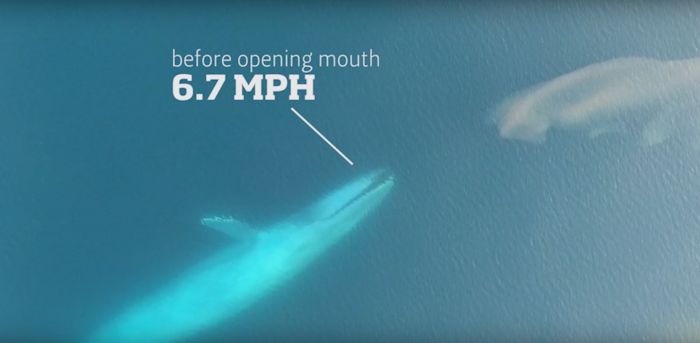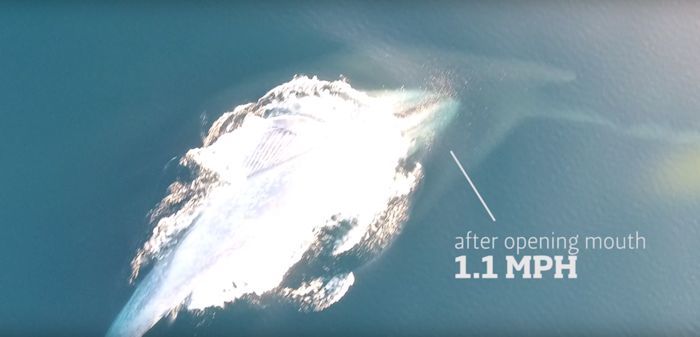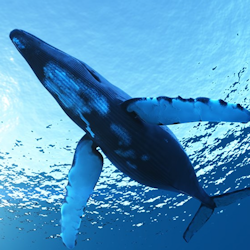Blue Whale Eating Krill
Lesson Plans > Science > Physics > EnergySlide Show


Lesson Plan/Article
Blue Whale Eating Krill

In this lesson, students will estimate how many krill a blue whale must eat in a single mouthful, in order to make the meal worthwhile for the whale.
Background: I've heard it said that raw carrots and raw celery are "negative energy foods." I haven't researched to verify this claim, but it's a good starting point for a discussion about food and energy. The concept of a negative energy food is that it takes more work to chew and digest it than the amount of energy you gain from it. In other words, if it takes 100 Calories of work to chew something, and you only gain 80 Calories from the food, then you have essentially lost 20 calories by consuming the food. The concept of a negative calorie meal applies to blue whales; when the blue whale opens his mouth to swallow a school of krill, his open mouth acts (as one of my physics students described it) as a "water parachute." The whale slows down, and then must expend energy getting back up to speed after eating the krill. If the amount of energy consumed does not match the amount of energy needed to get back up to speed, the whale would be better off not eating at all.
The Video: Researchers at Oregon State University have produced a fantastic video: Blue Whale eating Krill, that shows views of a blue whale from a drone hovering over the ocean. This video shows the speed of the whale before opening its mouth, and the speed after opening its mouth. The entire video is worth watching in class; it's not very long. Alternately, stills have been provided in the slide show.
The Problem: Students will incorporate what they understand of energy and work to calculate how many krill the whale needs to eat. The kinetic energy of the whale can be calculated before and after opening its mouth. From there, students can use conversion factors, researched information about blue whales and krill, and food energy information to estimate the number of krill needed to make a "break-even" meal,
Approach #1: I do this with my students as an in-class project. I'm merely the "facilitator." I don't give them any information except what they request. For example, "Can you look up the mass of a krill?" or "How many kcal in a gram of krill?" This forces them think through everything they need for themselves.
Approach #2: A handout is provided with several conversion factors and biological data required to solve the problem. This makes the problem go more quickly, but also gives "hints" about the kinds of information students need, so if you want to force them to fully work out the reasoning and process for themselves, don't use the handout.
Approach #3: This could also be done as a research homework assignment which students have to research and write up.
For any of these approaches, the appended worksheet can be used to prompt students in the process. A solution key is provided.
Handouts/Worksheets
Physical Data and Unit Conversions
The following conversion factors and physical data may be of value in solving the whale-krill problem.
Physical Data
- Blue Whale weight: 300,000 pounds
- Krill weight: 0.035 ounces
- Energy per gram of krill: 0.95 kcal (Cal)
- Whale speed, mouth closed: 6.7 mph
- Whale speed, mouth open: 1.1 mph
Unit Conversions
- 1 pound = 16 ounces
- 1 Joule = 0.000239 kcal
- 1 slug = 14.59 kg
- 1 mile = 1609.34 m
Blue Whale Worksheet
Instructions: Answer the following questions to identify the minimum number of krill a blue whale must take in a mouthful in order for it to be a "worthwhile" meal.
- Explain why the whale slows down when approaching the school of krill.
- Calculate the energy loss when the whale slows down. Show your work, including any unit conversions.
- How does that relate to the amount of energy needed to get back up to speed? How does it relate to the amount of food energy the whale must get from the krill in order to not "lose out"?
- Calculate how many krill would be required to satisfy the energy need.
